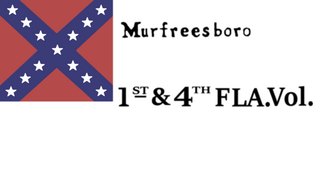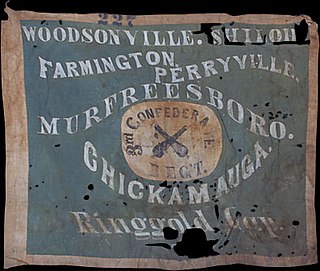
General Samuel Jones was a major general in the Confederate States Army during the American Civil War. At the midpoint of the war, he commanded the Department of Western Virginia, defending the Virginia and Tennessee Railroad and the vital salt mines. Later he commanded the district of South Carolina.

David Lang was a land surveyor, Confederate States Army officer during the American Civil War, civil engineer, and Florida politician.

Florida participated in the American Civil War as a member of the Confederate States of America. It had been admitted to the United States as a slave state in 1845. In January 1861, Florida became the third Southern state to secede from the Union after the November 1860 presidential election victory of Abraham Lincoln. It was one of the initial seven slave states which formed the Confederacy on February 8, 1861, in advance of the American Civil War.

The Iron Brigade, also known as The Black Hats, Black Hat Brigade, Iron Brigade of the West, and originally King's Wisconsin Brigade was an infantry brigade in the Union Army of the Potomac during the American Civil War. Although it fought entirely in the Eastern Theater, it was composed of regiments from three Western states that are now within the region of the Midwest. Noted for its strong discipline, its unique uniform appearance and its tenacious fighting ability, the Iron Brigade suffered the highest percentage of casualties of any brigade in the war.
Frederick L. Villepigue (1826–?) served as Secretary of State of Florida from July 1, 1853, to January 13, 1863.

The 1st Florida Cavalry Regiment was a Confederate army unit during the U.S. Civil War, originally organized in July 1861 at Tallahassee. Members of the regiment came primarily from Alachua, Clay, Columbia, Duval, Leon, Levy, Nassau and Suwannee counties. It left for the western theater in 1862.
The Kilcrease Light Artillery was a Confederate army artillery company.
Hispanics in the American Civil War fought on both the Union and Confederate sides of the conflict. Not all the Hispanics who fought in the American Civil War were "Hispanic-Americans", in other words citizens of the United States. Many of them were Spanish subjects or nationals from countries in the Caribbean, Central and South America. Some were born in a US Territory and therefore did not have the right to US Citizenship. It is estimated that approximately 20,000 Hispanics, mostly Mexican-Americans, Puerto Ricans and Cubans living in the United States joined the war: 2,500 for the Confederacy and 1,000 for the Union. This number increased to 10,000 by the end of the war.

The 11th Florida Infantry Regiment was an infantry regiment from Florida that served in the Confederate States Army from 1864 to 1865.
The 13th Arkansas Infantry (1861–1865) was a Confederate Army infantry regiment during the American Civil War. Organized mainly from companies, including several prewar volunteer militia companies, raised in northeastern Arkansas, the regiment was among the first transferred to Confederate Service, and spent virtually the entire war serving in Confederate forces east of the Mississippi River. After the unit sustained heavy casualties during the Battle of Murfreesboro, the unit spent most of the rest of the war field consolidated with the 13th Arkansas Infantry Regiment, to form the 5th/13th Arkansas Infantry Regiment.

8th Arkansas Infantry Regiment was an infantry formation in the Confederate States Army during the American Civil War. It served throughout the war in the western theater, seeing action in the Kentucky, Tennessee and Georgia campaigns. Following its depletion in numbers the regiment was consolidated several times with other Arkansas regiments, finally merging in 1865 into the 1st Arkansas Consolidated Infantry Regiment.
The 3d Arkansas Cavalry Regiment (1861–1865) was a Confederate Army Cavalry regiment during the American Civil War.

The 18th Arkansas Infantry (Marmaduke's) (1861–1865) was a Confederate Army infantry regiment during the American Civil War. The unit was also briefly identified as the 1st Arkansas Infantry Battalion. The unit was most often referred to as the 3rd Confederate Infantry Regiment. The designation "Confederate Infantry Regiment" was intended to convey the difference between Provisional Confederate Army units and Regular Confederate Army Units, with Provisional units being those regiments who received a state designation such as "XX Arkansas Infantry Regiment". In practice, the designation was most often utilized when Regiments were assembled utilizing companies from more than one Confederate state. The "3rd Confederate Infantry Regiment" is occasionally misidentified as the 3rd Arkansas Infantry Regiment commanded by Colonel Van H. Manning.

Theodore Washington Brevard Jr. was best known for having served as a military officer in the Confederate States Army. During his tenure with the Confederate army, he eventually reached the rank of Brigadier-General. Brevard was captured by the forces of General George Custer and imprisoned at Johnson's Island. He later died in 1882.
The 24th Arkansas Infantry (1861–1865) was a Confederate Army infantry regiment during the American Civil War. The unit began its service in the Department of the Trans-Mississippi, but the bulk of the unit was captured at the Battle of Arkansas Post and shipped to Northern prison camps. The unit was exchanged in Virginia and shipped to Tennessee and joined the Army of Tennessee in time for the Chattanooga Campaign and remained with the army through the Atlanta Campaign, the Franklin-Nashville Campaign and ended the war in North Carolina.

The 19th (Dawson's) Arkansas Infantry (1861–1865) was a Confederate Army infantry regiment during the American Civil War. The regiment was present for but not engaged during the Battle of Pea Ridge. At the Battle of Arkansas Post, the regiment became split, with part of the regiment surrendering with the garrison when the post capitulated. The captured portion of the regiment was eventually exchanged and released on the east side of the Mississippi and served the remainder of the war with the Confederate Army of Tennessee. The un-captured portion of the regiment was consolidated with the remnants of the 24th Arkansas and served the remainder of the war in the Department of the Trans-Mississippi.
Benjamin F. Allen, also referred to as B. F. Allen, was an American lawyer and politician in the state of Florida. Allen served as the 5th Secretary of State of Florida.

The 12th Louisiana Infantry Regiment was a unit of volunteers recruited in Louisiana that fought in the Confederate States Army during the American Civil War. Formed in August 1861, the regiment served in the Western Theater of the American Civil War and was unique in that there were 12 companies. The regiment garrisoned Island Number Ten before being stationed at Fort Pillow. It fought at Second Corinth in 1862 and Champion Hill and Jackson in 1863. A detachment served during the Siege of Vicksburg and was captured. In 1864, the regiment fought in the Meridian, Atlanta, and Franklin–Nashville campaigns, suffering heavy losses at Peachtree Creek and Franklin. It fought at Bentonville in 1865 before surrendering with General Joseph E. Johnston.










